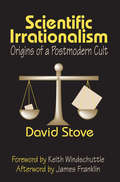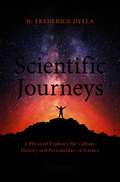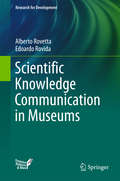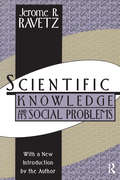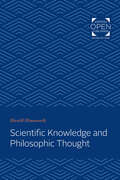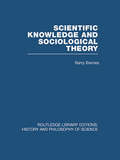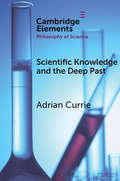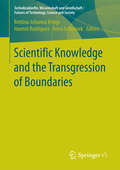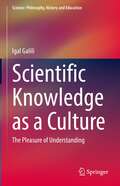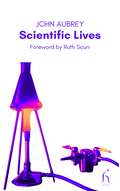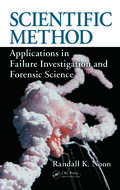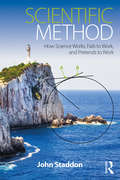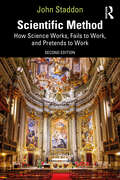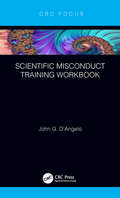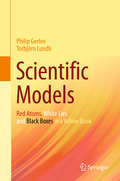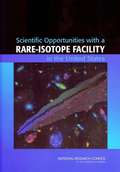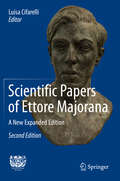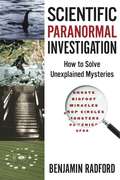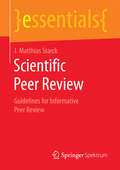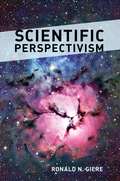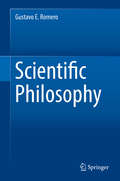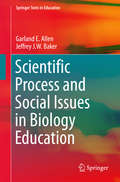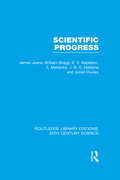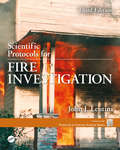- Table View
- List View
Scientific Irrationalism: Origins of a Postmodern Cult
by David StoveLittle known outside his native Australia, David Stove was one of the most illuminating and brilliant philosophical essayists of his era. A fearless attacker of intellectual and cultural orthodoxies, Stove left powerful critiques of scientific irrationalism, Darwinian theories of human behavior, and philosophical idealism.Since its inception in the 1940s, the field of science studies, originally intended to bridge the gap between science and the humanities, has been the center of controversy and debate. The most notable figures in this debate are Thomas Kuhn and Karl Popper. In Scientific Irrationalism, now available in paperback, David Stove demonstrates how extravagant has been the verbiage wasted on this issue and how irrational the combatants have been. He shows that Kuhn and Popper share considerable common ground. Stove argues that the problems all reside in the reasoning of the critics. He identifies the logical mistakes and conceptual allusions made by Kuhn and Popper and their supporters, as well as their collective dependency on a single argument made by the philosopher of the Scottish Enlightenment, David Hume. He then demonstrates how little potency that argument actually has for the claims of science.In his foreword, Keith Windschuttle explains the debate surrounding the field of science studies and explores David Stove's contribution as well as his lack of recognition. In an afterword, James Franklin discusses reactions to Stove's work.
Scientific Journeys: A Physicist Explores the Culture, History and Personalities of Science
by H. Frederick DyllaThis collection of essays traces a scientific journey bookmarked by remarkable mentors and milestones of science. It provides fascinating reading for everyone interested in the history, public appreciation, and value of science, as well as giving first-hand accounts of many key events and prominent figures. The author was one of the “sputnik kids” growing up in the US at the start of the space age. He built a working laser just two years after they were first invented, an experience that convinced him to become a physicist. During his 50-year career in physics, many personalities and notable events in science and technology helped to form his view of how science contributes to the modern world, including his conviction that the impact of science can be most effective when introduced within the context of the humanities - especially history, literature and the arts.From the Foreword by former U.S. Congressman, Rush D. Holt: In this volume, we have the wide-ranging thoughts and observations of Fred Dylla, an accomplished physicist with an engineer’s fascination for gadgets, a historian’s long perspective, an artist’s aesthetic eye, and a teacher’s passion for sharing ideas. Throughout his varied career [...] his curiosity has been his foremost characteristic and his ability to see the connection between apparently disparate things his greatest skill. [...] Here he examines the roots and growth of innovation in examples from Bell Laboratories, Edison Electric Light Company, and cubist painter Georges Braque. He considers the essential place of publishing in science, that epochal intellectual technique for learning how the world works. He shows the human enrichment and practical benefits that derive from wise investments in scientific research, as well as the waste resulting from a failure to embrace appropriate technologies.
Scientific Knowledge Communication in Museums (Research For Development Ser.)
by Edoardo Rovida Alberto RovettaThis book explains the general principles of scientific and technical communication in the context of modern museums. It also examines, with the aid of informative case studies, the different means by which knowledge can be transmitted, including posters, objects, explanatory guidance, documentation, and catalogues. Highlighting the ever more important role of multimedia and virtual reality components in communicating understanding of and facilitating interaction with the displayed object, it explores how network communications systems and algorithms can be applied to offer individual users the information that is most pertinent to them. The book is supported by a Dynamic Museums app connected to museum databases where series of objects can be viewed via cloud computing and the Internet and printed using 3D printing technology. This book is of interest to a diverse readership, including all those who are responsible for museums’ collections, operations, and communications as well as those delivering or participating in courses on museums and their use, communication design and related topics.
Scientific Knowledge and Its Social Problems
by Jerome R. RavetzScience is continually confronted by new and difficult social and ethical problems. Some of these problems have arisen from the transformation of the academic science of the prewar period into the industrialized science of the present. Traditional theories of science are now widely recognized as obsolete. In Scientific Knowledge and Its Social Problems (originally published in 1971), Jerome R. Ravetz analyzes the work of science as the creation and investigation of problems. He demonstrates the role of choice and value judgment, and the inevitability of error, in scientific research. Ravetz's new introductory essay is a masterful statement of how our understanding of science has evolved over the last two decades.
Scientific Knowledge and Philosophic Thought
by Harold HimsworthOriginally published in 1986. Are there two kinds of problems—the scientific and the philosophic—each requiring different methods for solution? Or are there, rather, two different ways of approaching a problem, each yielding a different answer according to the method used? Biomedical researcher Sir Harold Himsworth urges scientists not to shy away from using scientific methods to grapple with problems traditionally accepted as belonging to the province of philosophy. The difference between science and philosophy lies not in the problems to which they are directed, Himsworth argues, but rather in the methods they use for solving them. To the scientist, a proposition is something to be investigated; to the philosopher, something to be accepted as a basis for thought. Since the development of the scientific method, substantial progress has been made toward mastering problems in the natural environment. If we are ever to attain a degree of control over problems that derive from human activities, Himsworth claims that we only succeed by approaching them in a comparably objective way.
Scientific Knowledge and Sociological Theory (Routledge Library Editions: History & Philosophy of Science)
by Barry BarnesOriginally published in 1974. Scientific Knowledge and Sociological Theory centres on the problem of explaining the manifest variety and contrast in the beliefs about nature held in different groups and societies. It maintains that the sociologist should treat all beliefs symmetrically and must investigate and account for allegedly "correct" or "scientific" beliefs just as he would "incorrect" or "unscientific" ones. From this basic position a study of scientific beliefs is constructed. The sociological interest of such beliefs is illustrated and a sociological perspective upon scientific change is developed.
Scientific Knowledge and the Deep Past: History Matters (Elements in the Philosophy of Science)
by Adrian CurrieHistorical sciences like paleontology and archaeology have uncovered unimagined, remarkable and mysterious worlds in the deep past. How should we understand the success of these sciences? What is the relationship between knowledge and history? In Scientific Knowledge and the Deep Past: History Matters, Adrian Currie examines recent paleontological work on the great changes that occurred during the Cretaceous period - the emergence of flowering plants, the splitting of the mega-continent Gondwana, and the eventual fall of the dinosaurs - to analyse the knowledge of historical scientists, and to reflect upon the nature of history. He argues that distinctively historical processes are 'peculiar': they have the capacity to generate their own highly specific dynamics and rules. This peculiarity, Currie argues, also explains the historian's interest in narratives and stories: the contingency, complexity and peculiarity of the past demands a narrative treatment. Overall, Currie argues that history matters for knowledge.
Scientific Knowledge and the Transgression of Boundaries
by Bettina-Johanna Krings Hannot Rodríguez Anna SchleisiekThe aim of this book is to understand and critically appraise science-based transgression dynamics in their whole complexity. It includes contributions from experts with different disciplinary backgrounds, such as philosophy, history and sociology. Thus, it is in itself an example of boundary transgression. Scientific disciplines and their objects have tended to be seen as permanent and distinct. However, science is better conceived as an activity that constantly surpasses, erases and rebuilds all kinds of boundaries, either disciplinary, socio-ethical or ecological. This transgressive capacity, a characteristic trait of science and its applications, defines us as "knowledge societies. " However, scientific and technological developments are also sources of serious environmental and social concerns.
Scientific Knowledge as a Culture: The Pleasure of Understanding (Science: Philosophy, History and Education)
by Igal GaliliThis book, in its first part, contains units of conceptual history of several topics of physics based on the research in physics education and research based articles with regard to several topics involved in teaching science in general and physics in particular. The second part of the book includes the framework used, the approach considering science knowledge as a special type of culture – discipline-culture. Within this approach, scientific knowledge is considered as comprised of a few inclusive fundamental theories each hierarchically structured in a triadic pattern: nucleus-body-periphery. While nucleus incorporates the basic principles and body comprises their implementations in the variety of laws, models, and experiments, periphery includes concepts at odds to the nucleus. This structure introduces knowledge in its conceptual variation thus converting disciplinary knowledge to cultural-disciplinary one. The approach draws on history and philosophy of science (HPS) necessary for meaningful learning of science. It is exemplified in several aspects regarding teaching physics, presenting history in classes, considering the special nature of science, and using artistic images in regular teaching. The revealed conceptual debate around the chosen topics clarifies the subject matter for school students and teachers encouraging construction of Cultural Content Knowledge. Often missed in teachers' preparation and common curriculum it helps genuine understanding of science thus providing remedy of students' misconceptions reported in educational research.
Scientific Lives (Hesperus Classics)
by John Aubrey"The honourable Robert Boyle esq., the son of Richard Boyle, the first Earl of Cork, was born at Lismore in the county of Cork. He was nursed by an Irish nurse, after the Irish manner, where they put the child in a pendulous satchel instead of a cradle, with a slit for the child's head to peep out." This new selection from John Aubrey's enormous work of 17th-century biography, Brief Lives, brings together his writings on contemporary scientists, explorers and men of innovation, including astronomer Edmund Halley, celebrated mapmaker Wenceslaus Hollar, and the architects Christopher Wren and Inigo Jones. Simultaneously quirky, amusing, and informative, these pieces together provide a fascinating portrait of an exciting and inventive age.
Scientific Method in Brief
by Hugh G. Gauch Jr.The fundamental principles of the scientific method are essential for enhancing perspective, increasing productivity, and stimulating innovation. These principles include deductive and inductive logic, probability, parsimony and hypothesis testing, as well as science's presuppositions, limitations, ethics and bold claims of rationality and truth. The examples and case studies drawn upon in this book span the physical, biological and social sciences; include applications in agriculture, engineering and medicine; and also explore science's interrelationships with disciplines in the humanities such as philosophy and law. Informed by position papers on science from the American Association for the Advancement of Science, National Academy of Sciences and National Science Foundation, this book aligns with a distinctively mainstream vision of science. It is an ideal resource for anyone undertaking a systematic study of scientific method for the first time, from undergraduates to professionals in both the sciences and the humanities.
Scientific Method: Applications in Failure Investigation and Forensic Science (International Forensic Science and Investigation)
by Randall K. NoonMost failure or accident investigations begin at the end of the story: after the explosion, after the fire has been extinguished, or after the collapse. In many instances, information about the last event and the starting event is known reasonably well. Information about what occurred between these endpoints, however, is often unclear, confusing, and perhaps contradictory. Scientific Method: Applications in Failure Investigation and Forensic Science explains how scientific investigative methods can best be used to determine why and how a particular event occurred.While employing examples from forensic engineering, the book uses principles and ideas applicable to most of the forensic sciences. The author examines the role of the failure investigator, describes the fundamental method for investigation, discusses the optimal way to organize evidence, and explores the four most common reasons why some investigations fail. The book provides three case studies that exemplify proper report writing, contains a special chapter profiling a criminal case by noted forensic specialist Jon J. Nordby, and offers a reading list of resources for further study.Concise and illustrative, this volume demonstrates how the scientific method can be applied to failure investigation in ways that avoid flawed reasoning while delivering convincing reconstruction scenarios. Investigators can pinpoint where things went wrong, providing valuable information that can prevent another catastrophe.
Scientific Method: How Science Works, Fails to Work, and Pretends to Work
by John StaddonThis book shows how science works, fails to work, or pretends to work, by looking at examples from such diverse fields as physics, biomedicine, psychology, and economics. Social science affects our lives every day through the predictions of experts and the rules and regulations they devise. Sciences like economics, sociology and health are subject to more ‘operating limitations’ than classical fields like physics or chemistry or biology. Yet, their methods and results must also be judged according to the same scientific standards. Every literate citizen should understand these standards and be able to tell the difference between good science and bad. Scientific Method enables readers to develop a critical, informed view of scientific practice by discussing concrete examples of how real scientists have approached the problems of their fields. It is ideal for students and professionals trying to make sense of the role of science in society, and of the meaning, value, and limitations of scientific methodology in the social sciences.
Scientific Method: How Science Works, Fails to Work, and Pretends to Work
by John StaddonThis expanded second edition of Scientific Method shows how science works, fails to work or pretends to work by looking at examples from physics, biomedicine, psychology, sociology and economics.Scientific Method aims to help curious readers understand the idea of science, not by learning a list of techniques but through examples both historical and contemporary. Staddon affirms that if the reader can understand successful studies as well as studies that appear to be scientific but are not, they will become a better judge of the “science” in circulation today. To this end, this new edition includes a new chapter, What is Science?, which points out that science, like any human activity, has its own set of values, with truth being the core. Other new chapters focus on the emergence of AI and machine learning, science and diversity, and behavioral economics. The book also includes textual features such as bullet-points and text boxes on topical issues.Scientific Method is essential reading for students and professionals trying to make sense of the role of science in society, and of the meaning, value and limitations of scientific methodology.
Scientific Misconduct Training Workbook (Global Science Education)
by John Gaetano D'AngeloThe field of ethics in science aims to improve the way the audience perceives science, and this unique workbook discusses the areas of ethics and scientific misconduct. It provides assessments and exercises for learners to work through in groups or alone. Completion of the workbook but especially the assessment and tests will earn the learner a certificate for scientific misconduct training compiled by the author, and the certificate is available from the author's own website. This volume is a companion to the author's published volume, Ethics in Science: Ethical Misconduct in Scientific Research, Second Edition and will appeal to undergraduates, graduates and even high school students. Features: A unique training workbook in ethics and good conduct, easliy accessible and user friendly Unlike books in this area which mostly cover the theoretical foundations of ethics in science, here the author provides a practical workbook and ancillaries Case studies and a PowerPoint presentation are provided and readers will receive a certificate of completion There is a wealth of instructor resources available from the homepage A knowledge of scientific misconduct is of utmost importance in an era of mass higher education
Scientific Models
by Philip Gerlee Torbjörn LundhA zebrafish, the hull of a miniature ship, a mathematical equation and a food chain - what do these things have in common? They are examples of models used by scientists to isolate and study particular aspects of the world around us. This book begins by introducing the concept of a scientific model from an intuitive perspective, drawing parallels to mental models and artistic representations. It then recounts the history of modelling from the 16th century up until the present day. The iterative process of model building is described and discussed in the context of complex models with high predictive accuracy versus simpler models that provide more of a conceptual understanding. To illustrate the diversity of opinions within the scientific community, we also present the results of an interview study, in which ten scientists from different disciplines describe their views on modelling and how models feature in their work. Lastly, it includes a number of worked examples that span different modelling approaches and techniques. It provides a comprehensive introduction to scientific models and shows how models are constructed and used in modern science. It also addresses the approach to, and the culture surrounding modelling in different scientific disciplines. It serves as an inspiration for model building and also facilitates interdisciplinary collaborations by showing how models are used in different scientific fields. The book is aimed primarily at students in the sciences and engineering, as well as students at teacher training colleges but will also appeal to interested readers wanting to get an overview of scientific modelling in general and different modelling approaches in particular.
Scientific Opportunities with a RARE-ISOTOPE FACILITY in the United States
by National Research Council of the National AcademiesOver ten years ago, U.S. nuclear scientists proposed construction of a new rare isotope accelerator in the United States, which would enable experiments to elucidate the important questions in nuclear physics. To help assess this proposal, DOE and NSF asked the NRC to define the science agenda for a next-generation U.S. Facility for Rare Isotope Beams (FRIB). As the study began, DOE announced a substantial reduction in the scope of this facility and put off its initial operation date by several years. The study focused on an evaluation of the science that could be accomplished on a facility reduced in scope. This report provides a discussion of the key science drivers for a FRIB, an assessment of existing domestic and international rare isotope beams, an assessment of the current U.S. position about the FRIB, and a set of findings and conclusions about the scientific and policy context for such a facility.
Scientific Papers of Ettore Majorana: A New Expanded Edition
by Luisa CifarelliThis book presents in full the work of the Italian theoretical physicist Ettore Majorana and explains its impacts, which are still being felt. It opens with a contribution by A. Zichichi that considers in depth the scientifi c genius of Majorana. This introductorychapter is followed, in chronological order, by the eleven scientifi c papers by this great scientist, in most cases translated into English for the fi rst time. Each paper is accompanied by a comment from an expert in the fi eld in question. Although very few in number, Majorana’s papers constitute a heritage of undeniable value and extraordinary scientifi c meaning, since they laid the foundations for research fi elds that remain topical today. With this in mind, two additional contributions on ongoing developments in these research fi elds are included: one on neutrino physics and the other on Majorana fermions in condensed matter. The volume closes with a note on Majorana’s life until his ill-fated disappearance.
Scientific Paranormal Investigation: How to Solve Unexplained Mysteries
by Benjamin RadfordThis book is about the scientific methods used to investigate mysteries with real life case studies and how they were solved.
Scientific Peer Review: Guidelines for Informative Peer Review (essentials)
by J. Matthias StarckJ. Matthias Starck comprehensively guides the reader in this essential through all steps of writing an expert review for a scientific journal. It is built on a succinct analysis how science works, how science is communicated and how science is published. It provides a critical guide how to write good, informative and fair peer reviews. The author presents a critical discussion of different peer review procedures and their alternatives, explains ethical guidelines as well as the dark sides of scientific publishing. So this essential helps the reader to perform better in the existing system and to contribute to its further development and improvement.
Scientific Perspectivism (Science And Its Conceptual Foundations Ser.)
by Ronald N. GiereMany people assume that the claims of scientists are objective truths. But historians, sociologists, and philosophers of science have long argued that scientific claims reflect the particular historical, cultural, and social context in which those claims were made. The nature of scientific knowledge is not absolute because it is influenced by the practice and perspective of human agents. Scientific Perspectivism argues that the acts of observing and theorizing are both perspectival, and this nature makes scientific knowledge contingent, as Thomas Kuhn theorized forty years ago.Using the example of color vision in humans to illustrate how his theory of “perspectivism” works, Ronald N. Giere argues that colors do not actually exist in objects; rather, color is the result of an interaction between aspects of the world and the human visual system. Giere extends this argument into a general interpretation of human perception and, more controversially, to scientific observation, conjecturing that the output of scientific instruments is perspectival. Furthermore, complex scientific principles—such as Maxwell’s equations describing the behavior of both the electric and magnetic fields—make no claims about the world, but models based on those principles can be used to make claims about specific aspects of the world. Offering a solution to the most contentious debate in the philosophy of science over the past thirty years, Scientific Perspectivism will be of interest to anyone involved in the study of science.
Scientific Philosophy
by Gustavo E. RomeroThis textbook presents the basics of philosophy that are necessary for the student and researcher in science in order to better understand scientific work. The approach is not historical but formative: tools for semantical analysis, ontology of science, epistemology, and scientific ethics are presented in a formal and direct way. The book has two parts: one with the general theory and a second part with application to some problems such as the interpretation of quantum mechanics, the nature of mathematics, and the ontology of spacetime. The book addresses questions such as "What is meaning?", "What is truth?", "What are truth criteria in science?", "What is a theory?", "What is a model?" "What is a datum?", "What is information?", "What does it mean to understand something?", "What is space?", "What is time?", "How are these concepts articulated in science?" "What are values?" "What are the limits of science?", and many more. The philosophical views presented are "scientific" in the sense that they are informed by current science, they are relevant for scientific research, and the method adopted uses the hypothetical-deductive approach that is characteristic of science. The results and conclusions, as any scientific conclusion, are open to revision in the light of future advances. Hence, this philosophical approach opposes to dogmatic philosophy. Supported by end-of-chapter summaries and a list of special symbols used, the material will be of interest for students and researchers in both science and philosophy. The second part will appeal to physicists and mathematicians.
Scientific Process and Social Issues in Biology Education
by Garland E. Allen Jeffrey J. W. BakerThis book complements fact-drive textbooks in introductory biology courses, or courses in biology and society, by focusing on several important points: (1) Biology as a process of doing science, emphasizing how we know what we know. (2) It stresses the role of science as a social as well as intellectual process, one that is always embedded in its time and place in history. In dealing with the issue of science as a process, the book introduces students to the elements of inductive and deductive logic, hypothesis formulation and testing, the design of experiments and the interpretation of data. An appendix presents the basics of statistical analysis for students with no background in statistical reasoning and manipulation. Reasoning processes are always illustrated with specific examples from both the past (eighteenth and nineteenth century) as well as the present. In dealing with science and social issues, this book introduces students to historical, sociological and philosophical issues such as Thomas Kiuhn's concept of paradigms and paradigm shifts, the social-constructions view of the history of science, as well as political and ethical issues such human experimentation, the eugenics movement and compulsory sterilization, and religious arguments against stem cell research and the teaching of evolution in schools. In addition to specific examples illustrating one point or another about the process of biology or social-political context, a number of in-depth case studies are used to show how scientific investigations are originated, designed, carried out in particular social/cultural contexts. Among those included are: Migration of monarch butterflies, John Snow's investigations on the cause of cholera, Louis Pasteur's controversy over spontaneous generation, the mass extinction of the dinosaurs, and the Tuskegee syphilis experiment.
Scientific Progress (Routledge Library Editions: 20th Century Science)
by James Jeans J.B.S. Haldane William Bragg E.V. Appleton E. Mellanby Julian S. HuxleyFirst published in 1936, this volume contains six of the Halley Stewart Lectures – originally founded "For Research towards the Christian Ideal in All Social Life" – by some of the greatest of English scientists of the mid-20th century, each a leading authority in his respective field: cosmology, physics, meteorology, medicine and genetics. The final lecture considers the relationship between scientific knowledge and human ideals, commenting on the paradox that a century which produced such scientific advance also witnessed the most concentrated period of social, economic and political turmoil in world history.
Scientific Protocols for Fire Investigation, Third Edition (Protocols in Forensic Science #5)
by John J. LentiniScientific Protocols for Fire Investigation, Third Edition focuses on the practical application of fundamental scientific principles to determine the causes of fires. Originally published in 2006, the First Edition was very well received by fire investigators and those who work with them. Since fire investigation is a rapidly evolving field—driven by new discoveries about fire behavior—the Second Edition was published in late 2012. This latest, fully updated Third Edition reflects the most recent developments in the field. Currently, serious research is underway to try to understand the role of ventilation in structure fires. Likewise, there is improved understanding of the kinds of errors investigators can make that lead to incorrect determinations of the causes of fires. In addition to the scientific aspects, the litigation of fire related events is rapidly changing, particularly with respect to an investigator's qualifications to serve as an expert witness. This book covers these latest developments and ties together the changing standards for fire investigations with the fundamental scientific knowledge presented in the early chapters of the book. The book is intended for those individuals who have recently entered the field of fire investigation, and those who are studying fire investigation with a plan to become certified professionals. In addition, professionals in the insurance industry who hire fire investigators will find this an invaluable resource. Insurance companies have sustained significant losses by hiring individuals who are not qualified, resulting in cases being settled or lost at a cost of millions. Insurance adjusters and investigators will learn to recognize quality fire investigations and those that are not up to today's standards. Lastly, this book is also for the many attorneys who litigate fire cases. Written with language and terms that make the science accessible even to the non-scientist, this new edition will be a welcome resource to any professional involved in fire and arson cases.
